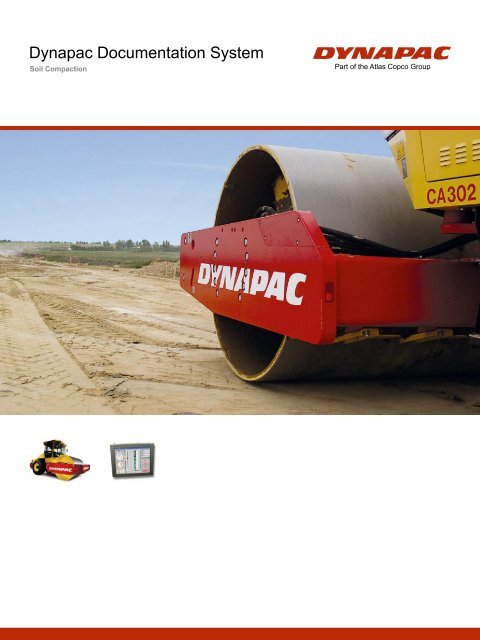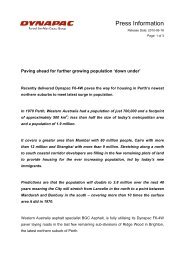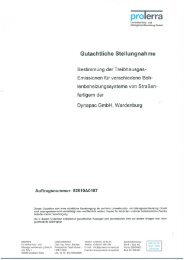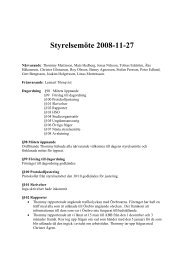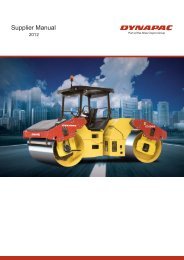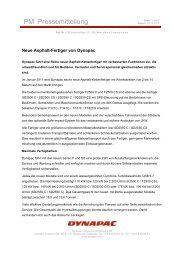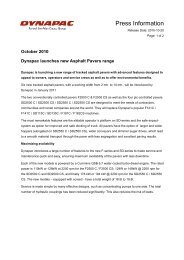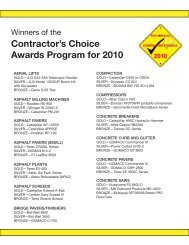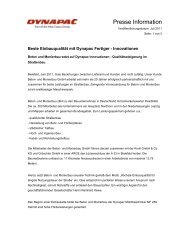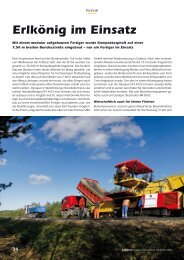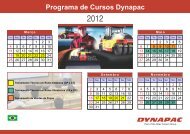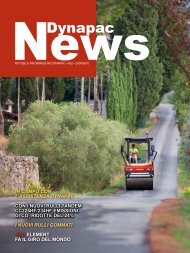DCA-S - Dynapac
DCA-S - Dynapac
DCA-S - Dynapac
You also want an ePaper? Increase the reach of your titles
YUMPU automatically turns print PDFs into web optimized ePapers that Google loves.
<strong>Dynapac</strong> Documentation System<br />
Soil Compaction
<strong>Dynapac</strong> Documentation System<br />
<strong>Dynapac</strong>’s experience of surface covering compaction control<br />
dates from the late 70s. Since then we have offered our<br />
customers the opportunity to control the compaction work<br />
in real time and to document the completed work for improved<br />
quality control, from the first display instruments via belt<br />
printers and simple computers to today’s advanced but still<br />
user-friendly systems.<br />
The compaction meter registers the movement of the drum in<br />
the vertical plane. This movement changes as the compaction<br />
increases and the rigidity of the underlying surface increases.<br />
In principle it can be compared with bouncing a golf ball on<br />
different surfaces. On loose surfaces (non-compacted sand)<br />
there is basically no bounce, while on a hard surface (concrete)<br />
there is a very good bounce. The better the bounce, the higher<br />
the CMV. We do not know, however, exactly how high the<br />
<strong>Dynapac</strong>’s documentation system is built up in three levels. At<br />
the basic level there is the compaction meter. This can then be<br />
expanded with increasingly more advanced documentation<br />
tools in the form of computers mounted on the roller with different<br />
positioning systems. The compaction meter consists of<br />
the following main parts:<br />
1. Sensor (accelerometer)<br />
2. Processor unit<br />
3. Display instrument<br />
The sensor registers the vibratory movement of the roller and<br />
this information is then transferred to the processor, where it is<br />
analysed. The analysed information is presented on the display<br />
instrument as a digital value, CMV (Compaction Meter Value).<br />
A high or low measurement range (CMV 0-150 and 0-50) can<br />
be selected with a switch on the instrument panel.<br />
The compaction meter provides a relative measurement of<br />
rigidity of the surface. This increases with an increase in the<br />
compaction and is reflected in a rising CMV. An accelerometer<br />
continuously measures the compaction forces that occur as<br />
the vibratory drum works the surface. The signals from the accelerometer<br />
change as the surface becomes harder and more<br />
stable. The signals are then converted via a patented principle<br />
to values that can be read on the roller’s instrument panel. The<br />
compaction meter value (CMV), which is non-dimensional, can<br />
be calibrated to the test method used for acceptance inspection<br />
(degree of compaction, deformation module (Ev2) ETC). Each<br />
new compaction job is therefore initiated by compacting test<br />
areas to different levels and in this way correlating CMV to the<br />
degree of compaction.<br />
<strong>DCA</strong> is an abbreviation of <strong>Dynapac</strong> Compaction Analyzer. It<br />
registers all the CMV data and allows the operator to see the<br />
compaction results on the computer screen. On the basis of<br />
experience or an existing calibration, the CMV limiting value<br />
can be used for each separate compaction job. The <strong>DCA</strong> will<br />
then indicate precisely which areas require additional compaction.<br />
The computer gives the operator a graphic image of<br />
the completed compaction work. Variations in CMV are shown<br />
as different colours on the surface and it is therefore easy to<br />
identify weaker areas and take the requisite action. In most<br />
Background<br />
Introduction<br />
bounce is (or how well-compacted the area is). This requires<br />
the compaction meter to be calibrated to the static flat load<br />
or the density values.<br />
Regardless of whether the system has been calibrated or not,<br />
the roller operator continuously receives information on the<br />
increase in the compaction, whereby an increasing CMV means<br />
an increase in the compaction. When the increase in CMV<br />
levels off you start to approach the limit to what the machine<br />
can achieve on the surface in question, and further compaction<br />
can be uneconomic or even damaging.<br />
The compaction meter also gives an indication as to whether the<br />
area is uniformly compacted (the same CMV over the entire area)<br />
or if the surface has irregular rigidity (large variations in CMV).<br />
cases it is sufficient to make additional runs over an area to<br />
achieve satisfactory compaction, but some areas may need<br />
to be improved by excavating poor material and replacing it<br />
with new material.<br />
The <strong>DCA</strong> unit is portable and the measurement results can<br />
therefore be taken into the office and studied. It is also easy to<br />
transfer the measurement data to a standard PC by means of<br />
a memory card so that it can be permanently stored.<br />
Compaction meter<br />
The display instrument gives the roller operator continuous<br />
information on the increase in compaction and any weak areas.<br />
At the end of the compaction work the CMV stabilises and the<br />
Bouncing warning starts to flash. This indicates that the machine<br />
cannot significantly improve the compaction and that further<br />
runs are uneconomical.<br />
Compaction meter with <strong>DCA</strong><br />
The same function as above, but with the opportunity to document<br />
the end results for quality assurance and as an indication<br />
for acceptance inspection. The <strong>DCA</strong> can be set to show two or<br />
more surfaces with the lowest CMV (least bearing strength).<br />
The compaction documentation is stored in the computer and<br />
can easily be transferred to other computers for more detailed<br />
analysis or printout. It is also possible in <strong>DCA</strong> to calibrate CMV to<br />
static flat loads, and thereby obtain a receipt when the correct<br />
compaction has been achieved.<br />
Compaction meter with <strong>DCA</strong>-GPS<br />
The same function as above, but all the runs can be documented<br />
which gives the roller operator full control of the increase<br />
in compaction over the entire area. The <strong>DCA</strong> also shows the<br />
position of the roller in relation to a selected reference line for<br />
the section, which eliminates the need for extra setting out<br />
to orientate the operator. The analysis function enables the<br />
compaction work to be replayed to assess if the roller has been<br />
used efficiently or if the roller pattern needs to be optimized.<br />
At the same it is possible to see how many runs have been allocated<br />
over the surface and which CMV have been achieved.<br />
The results from the acceptance inspection can be entered in<br />
the <strong>DCA</strong> so that the results from quality control can be collected<br />
together in one place.
2<br />
CMV<br />
3<br />
1<br />
2<br />
3<br />
1<br />
Rock<br />
Compaction meter<br />
A <strong>Dynapac</strong> roller with a compaction meter is much<br />
more than just a compaction machine. The compaction<br />
meter gives the roller operator information on<br />
the increase in compaction for each run, it shows<br />
variations in the rigidity of the underlying surface,<br />
it can localize weak areas, and it indicates when the<br />
material is fully compacted. The compaction meter<br />
also tells the roller operator if the roller does double<br />
jumps, which can damage both the roller and the<br />
compacted material. Avoiding double jumps save<br />
both time and money. The compaction meter also<br />
helps to avoid an unnecessary number of runs,<br />
which reduces both fuel consumption and wear<br />
on the machines.<br />
Sensor (accelerometer)<br />
A sensor (1) sits on the vibrating part, which continuously registers<br />
the movement of the drum. The signals from the sensor are<br />
sent to a processor unit (2), where they are processed.<br />
Processor unit<br />
Clay<br />
The signals from the sensor (1) are processed in a processor (2)<br />
and presented as CMV (compaction meter value) on the instrument<br />
panel (3).<br />
Display instrument (CMV instrument)<br />
The CMV indicates the rigidity of the compacted material. The<br />
higher the CMV, the more rigid and more compacted the material<br />
is. When CMV no longer increases during additional runs this<br />
means that maximum compaction has been reached during the<br />
present conditions.
Compaction meter and <strong>DCA</strong>-S<br />
A <strong>Dynapac</strong> vibratory roller with compaction meter and <strong>DCA</strong>-S is a<br />
reliable system for the control of compaction, and thereby guarantees<br />
first-rate quality in your next project.<br />
The operator can continuously read the compaction results on<br />
his instrument panel. As opposed to conventional measurement<br />
methods, the compaction meter provides continuous measurement<br />
results and not only random samples as before.<br />
The <strong>Dynapac</strong> Compaction Analyzer registers all the measurement<br />
values from the compaction meter, while at the same time<br />
the operator can see the compaction results immediately on the<br />
computer screen.<br />
<strong>Dynapac</strong> has developed this unique combination so that the<br />
compaction will be correct from the very start.<br />
A genuinely profitable machine!<br />
2<br />
3<br />
Careful compaction of each layer of soil provides a significant<br />
improvement of the bearing strength of the earth materials. A uniform<br />
bearing strength in each layer prevents uncontrolled settlements in<br />
the future.<br />
Correctly used, a vibratory roller is the perfect machine for<br />
compaction work. If, moreover, you can use the same machine for<br />
compaction control it is an excellent instrument in the compaction<br />
process. It helps you to localize areas where additional compaction<br />
is needed to achieve uniformity and satisfactory compaction characteristics.<br />
5<br />
4<br />
1
CMV<br />
140<br />
120<br />
100<br />
80<br />
60<br />
40<br />
20<br />
Rock Clay<br />
10 20 30 40 50<br />
1<br />
2<br />
3<br />
4<br />
5<br />
The Drum accelerometer registers the compaction.<br />
The Rear axle sensor registers the longitudinal<br />
position.<br />
The Processor processes the signals from the accelerometer.<br />
The compaction meter measures the bearing strength<br />
of the surface in CMV, where CMV stands for Compaction<br />
Meter Value.<br />
The results of the compaction are shown directly on the<br />
screen of the portable <strong>DCA</strong> unit. The measurement values<br />
can easily be transferred to a desktop computer by means<br />
of a memory card.
Compaction meter and <strong>DCA</strong>-S (GPS)<br />
A <strong>Dynapac</strong> vibratory roller with compaction meter and <strong>DCA</strong>-S<br />
(GPS) is a reliable system for the control of compaction, and thereby<br />
guarantees first-rate quality in your next project.<br />
The operator can continuously read the compaction results on<br />
his instrument panel. As opposed to conventional measurement<br />
methods, the compaction meter provides continuous measurement<br />
results and not only random samples as before.<br />
The <strong>Dynapac</strong> Compaction Analyzer registers all the measurement<br />
values from the compaction meter, while at the same time<br />
the operator can see the compaction results immediately on the<br />
computer screen.<br />
<strong>Dynapac</strong> has developed this unique combination so that the<br />
compaction will be correct from the very start.<br />
A genuinely profitable machine!<br />
2<br />
3<br />
A <strong>Dynapac</strong> Compaction Analyzer means that:<br />
· The compaction energy can be concentrated to the ground surfaces<br />
that need additional compaction.<br />
· No unnecessary compaction of already finished surfaces.<br />
· The risk of inferior or exaggerated compaction is eliminated.<br />
· Each stage of the compaction work is documented, and high-quality<br />
documentation of the compacted area is obtained immediately.<br />
In other words you now have a much greater opportunity to achieve:<br />
· First-rate compaction results with maximum uniformity in terms of<br />
the bearing strength of each layer.<br />
· Simple quality assurance.<br />
· More efficient compaction.<br />
· The best possible economy for both contractors and purchasers.<br />
5<br />
4<br />
6<br />
1
CMV<br />
140<br />
120<br />
100<br />
80<br />
60<br />
40<br />
20<br />
Rock<br />
1<br />
2<br />
3<br />
4<br />
5<br />
6<br />
Clay<br />
10 20 30 40 50 60<br />
70<br />
The Drum accelerometer registers the compaction.<br />
The Rear axle sensor registers the longitudinal<br />
position.<br />
The Processor processes the signals from the accelerometer.<br />
The compaction meter measures the bearing strength<br />
of the surface in CMV, where CMV stands for Compaction<br />
Meter Value.<br />
The results of the compaction are shown directly on the<br />
screen of the portable <strong>DCA</strong> unit. The measurement values<br />
can easily be transferred to a desktop computer by means<br />
of a memory card.<br />
The roller is in contact with a positioning system via the<br />
GPS aerial on the roof, which explains exactly where<br />
the machine is.
Functions of the Compaction Meter<br />
· Continuous measuring of the rigidity of the underlying surface.<br />
· Warns the operator of double jumping/overcompaction.<br />
<strong>Dynapac</strong> Compaction Analyzer<br />
· Two measurement scales, CMV 0-50 for fine-grained material and CMV 0-150 for the rest.<br />
Functions of <strong>DCA</strong>-S<br />
In addition to the functions of the Compaction Meter:<br />
· Continuous registering of measured values.<br />
· Calibration to Ev2 ETC.<br />
· Search function to localize the weakest areas for acceptance inspection.<br />
· Graphic presentation of the compaction results during the compaction work.<br />
· Integrated analysis function.<br />
· Printout function.<br />
Functions of <strong>DCA</strong>-S (GPS)<br />
In addition to the function of the compaction meter and <strong>DCA</strong>-S:<br />
· Integrated conversion of WGS84 coordinates to local coordinate system.<br />
· Absolute positioning of measured values in local coordinate system.<br />
· A digital road line model provides the roller operator with information on the current position (section/lateral measurement).<br />
Compaction meters <strong>DCA</strong>-S and <strong>DCA</strong>-S (GPS) are installed in the following machines (factory fitted or post-factory fitted)<br />
· CA 150/250/260/280 (compaction meter only)<br />
· CA 152–702<br />
<strong>Dynapac</strong> Compaction Equipment AB, Box 504, SE-371 23 Karlskrona, Sweden. Tel: +46 455 30 60 00, Fax: +46 455 30 60 30<br />
We reserve the right to change specifications without notice. Photos and illustrations do not always show standard versions of machines.<br />
The above information is a general description only, is not guaranteed and contains no warranties of any kind.<br />
3492 0033 01 - February 2009


